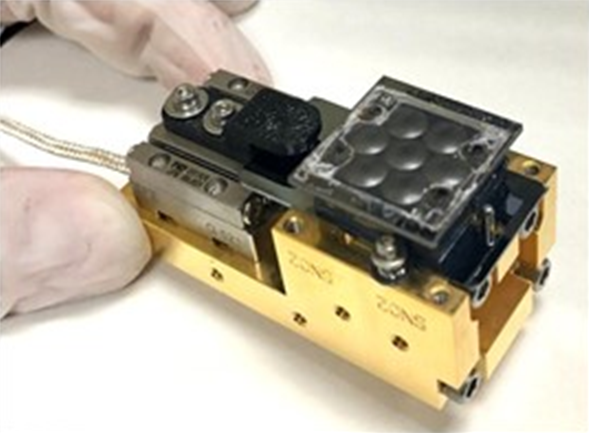Quasi-Optical Systems
Contact: Nuria Llombart

THz waves are sandwiched between micro and optical waves with frequencies in the order from 100 GHz up to 10 THz. In this part of the spectrum, the technology is not as mature as in optics or microwaves. Electronics have their cut-off frequencies in the THz region while waves are not very energetic at these frequencies. Therefore there is very little power to work with, every single dB counts! So if there is not mature technology and little power to work with, why we should even bother to look into this part of the spectrum? Traditionally, the main interest to develop THz systems has been space science. To study the origins of the universe, performing spectroscopy to measure the intrinsic resonance of big molecules, such water, which can be measured from far distances in comets and planets. Because of the advancement in technology, and the need for bandwidth, the world-wide industry is looking now to higher frequencies. The larger available bandwidth at these higher frequencies will enable much faster wireless links, indeed 5G is already exploiting mm-wavelengths, and this trend will continue with 6G. Radars operating at few hundreds GHz are being used to detect objects with high resolution for multiple industrial applications.
The problem of limited power in this spectral band has been traditionally overcome via the use of Quasi-Optical systems coupled to single receivers, which were extensively developed in the 80-90s for space applications. The term Quasi-optics (QO) is actually much older, microwaves were originally for a brief time name quasi-optics when physics were trying to demonstrate that signals at low frequencies propagate like the light does. Nowadays the accepted definition, reintroduced by Leopold Felsen in 1960, concerns the propagation of EM radiation through optical components whose size is comparable to the wavelength where diffraction phenomena is relevant. And it is pretty much associated with mm-wave and THz systems. Thanks to the use of these components, the radiation can be focused into a certain direction and gains in the order from 20 to 50 dB with respect to a nearly isotropic case such a dipole antenna.
The EM field picture in these systems is not as simple as in the previous picture since strong diffraction effects are present, as well as the difficulty to integrate the QO antenna with the front-end. For designing these QO systems is fundamental to master electromagnetics, and this is the area that we do research on.
We start from the application of advanced electromagnetic theoretical models for the development of state-of-the-art QO components with the objective of demonstrating low/medium TRL proof of concept systems with unique capabilities for XG sensing and communications applications. Key areas that we focus on are:
- Quasi-optical systems for imaging cameras (Active and Passive) in the context of security and automotive applications
- Quasi-optical systems for space sensing above 100 GHz
- Quasi-optical systems for XG communications
Projects under this theme
Future Network Services 6G
Nationaal Groeifonds
Development of packaging technology at sub-terahertz frequencies
Towards Energy-Efficient Tbps Wireless Links
TeraGreen will develop ultra wideband and low-power consumption BiCMOS transmitters and receivers integrated with lens array architectures at 300GHz, combined with baseband algorithms suitable for energy-efficient analog-to-digital conversion.
Sub-THz Antennas for Next Generation Automotive Radars
Research towards the next generation of car radar systems at 140 GHz
THz silicon-Integrated CAMera for low-cost imaging applications
Develop a real-time multi pixel passive radiometer, operating between 0.1 THz and 1THz, integrated in a silicon based technology, with temperature resolution better than 1K
UNB-Lens-Arrays
Lens Antenna Array for Ultrafast Wireless Communication
History
Multi Object Spectrometer with an Array of superconducting Integrated Circuits
Redshift instrument simultaneously measures 25 galaxies
STG-ERC Lens Antenna Arrays for THz Coherent Cameras
STG-ERC Grant no. 639749
Concealed Objects Stand-Off Real-Time Imaging for Security
The project will develop a demonstrator for stand-off real-time concealed object detection for future implementations of high throughput security screening for European mass-transit markets and infrastructure security.
THz Imaging Phenomenology Platforms for Stand-off IED Detection funded by the European Defense Agency
The objectives of the Project are to produce an imagery phenomenology study for evaluation of the detection problem centred around the detection of concealed objects and map the route towards potential applications.
Kinetic Inductance Detectors: a new imaging technology for observations in and from space
Imaging arrays of kinetic inductance detectors for space-based astronomical and earth observation applications
THz silicon-integrated camera for low-cost imaging applications
Develop a real-time multi pixel passive radiometer, operating between 0.1 THz and 1THz, integrated in a silicon based technology, with temperature resolution better than 1K
MSc students
- Carlo Ricci Spadoni
Alumni
- Martí Xargay Ferrer (2025)
- Tom Geerling (2025)
- Çağın Sarı (2025)
- Zerui Gao (2024)
- Junyao Tan (2023)
- Robbin van Dijk (2023)
- Muhan Zhang (2023)
- Alexandros Bechrakis Triantafyllos (2023)
- Leila Gottmer (2022)
- Rik Bokhorst (2022)
- Dunja Lončarević (2022)
- Ashwita Nair (2021)
- Saurabh Nerkar (2021)
- Nick van Rooijen (2021)